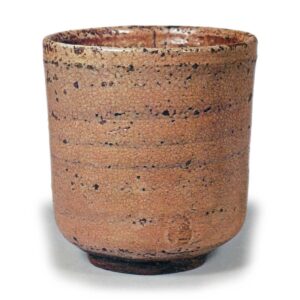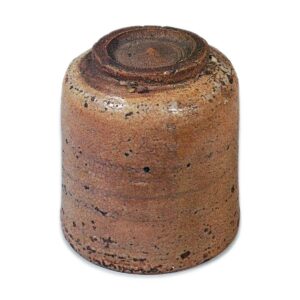

Height 10.4 cm, mouth diameter 9.5 cm, base diameter 5.5 cm
Hokuriku University
It is said to have belonged to Rikyu, and on the back of the lid of the inner box, there is an inscription by Kanjian Munenobu, “Rikyu Resident, Three Cylinders, Possession of Kyogen Hakama, Hoki, Ne-noko Mochi”, which is a famous bowl called “Rikyu’s three cylinders”. On the cover of the inner box, Hosokawa Sansai inscribed the inscription “Child’s Cake”, a name with a special meaning that appears only once in “The Tale of Genji”. In the old days, aristocrats would eat rice cakes on the day of the boar at the beginning of the tenth month of the lunar calendar to celebrate good health and prosperity of offspring.
In the Aoi no Maki volume of The Tale of Genji, there is a scene in which Genji recommends Boar’s Child Rice Cakes to Murasaki, and since that day fell on the day after the Day of the Boar, the name “ko no ko” was coined. The number of the three rice cakes was named after the phrase in the text, “Three is one, but once upon a time,” which was used as the name of this tea bowl, which was one of the three cylinders owned by Rikyu. This naming can be said to be unique to Hosokawa Sansai, who was well versed in the classics.
By the way, the fact that Sen no Rikyu, who died in 1591 (Tensho 19), owned this tea bowl is of great significance in estimating the date of the tea bowl Karatsu ware. This tubular tea bowl is clearly made as a tea bowl, not as a miscellaneous bowl. If this is the case, it means that tea bowls made consciously in Karatsu ware were fired in the late Tensho period, and it is thought that many of the Okukoraite tea bowls with similar glaze were also fired in the late Tensho period or earlier.
The tea bowl is rather thick and is wheel-thrown, and its shape shows its antiquity among many Karatsu tea bowls, and the loquat-colored glaze is soft. The rudely carved base is somewhat thinned to reveal a reddish clay surface, and a large finger mark remains at the waist.
This pottery was passed down from Rikyu to Hosokawa Sansai, Takagi Gensai, Kanjian Munenobu (Sakamoto Shusai), Imai Gennojo, Suwa Nobuto, Konoike family, and others.



